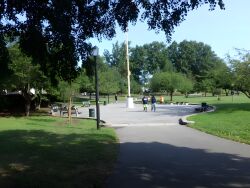Archie Spigner Park
Musician's Oval
What was here before?
In 1861, landowners John and Maria Remsen sold Mill Pond, Mill Brook, and the land surrounding the bodies of water, which included this site, to the Town of Jamaica for its water supply system. In the deed the parcel was defined using “a certain Buttonwood tree” as a reference point. In 1898, the property was transferred to the City of New York upon consolidation of the five boroughs.
How did this site become a park?
Most of the site was transferred to NYC Parks in 1914. The park was named St. Albans Memorial Park in 1932, before being renamed Archie Spigner Park in 2022. Subsequent parcels were added between 1936 and 1968. By the 1930s the formerly wooded property acquired a more formal design, with a central lawn and surrounding pathways.
The lawn, a favorite location for stargazing, was renovated in 2001 with paved constellations at six entrances to oval with the date, time, and orientation at which they can be seen best. The flagpole to the north of the lawn acts as a timepiece telling the hour with its shadow.
The community holds regular events, concerts, and jazz festivals in the space, and appropriate homage to the neighborhood’s musical history.
Who is this oval named for?
In 2021, as part of the second phase of NYC Parks’ initiative to expand the representation of African Americans honored in parks, this feature was named Musician’s Oval for the numerous Black jazz luminaries who settled in the Addisleigh Park neighborhood.
Addisleigh Park, an enclave in the St. Albans area of southeastern Queens, is a landmarked historic district. The area was originally developed as a white neighborhood using racial restrictive contracts starting in the 1930s. However, Black families, including jazz phenoms such as Fats Waller, Lena Horne, and Count Basie, had moved to the area by the 1940s.
It was around this time that homeowners sued their neighbors for selling homes to African Americans. The judge ruled in favor of the plaintiffs but noted that more than 40 Black families lived in the neighborhood. In 1948, the Supreme Court ultimately ruled that racially restrictive covenants were unconstitutional, but the neighborhood was already predominately Black and known as a home to many famous Black musicians and sports figures. It was featured in Our World magazine describing it as a “swanky suburb [that] is home of the nation’s richest and most gifted Negroes.”
Addisleigh Park’s famous residents included jazz musicians Ella Fitzgerald, John Coltrane, Charlie Parker, Illinois Jacquet, James Brown, Milt Hinton, Ray Brown, Earl Bostic, Herbert Mills and Cootie Williams, as well as hundreds of other leaders in music, sports, the arts, and politics.
Check out your park's Vital Signs
Clean & Safe
Green & Resilient
Empowered & Engaged Users
Share your feedback or learn more about how this park is part of a
Vital Park System










